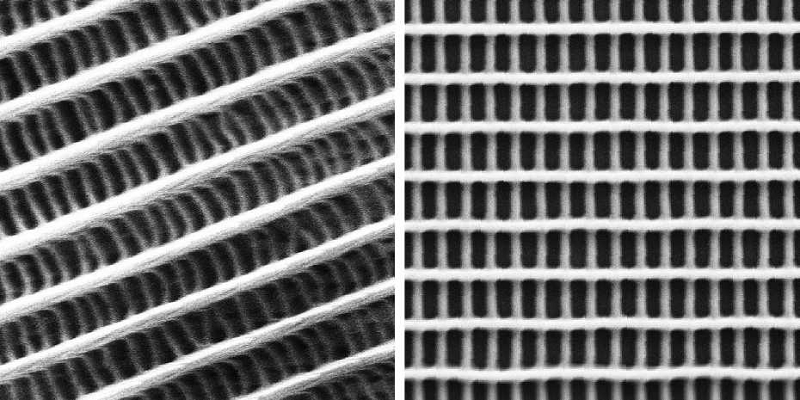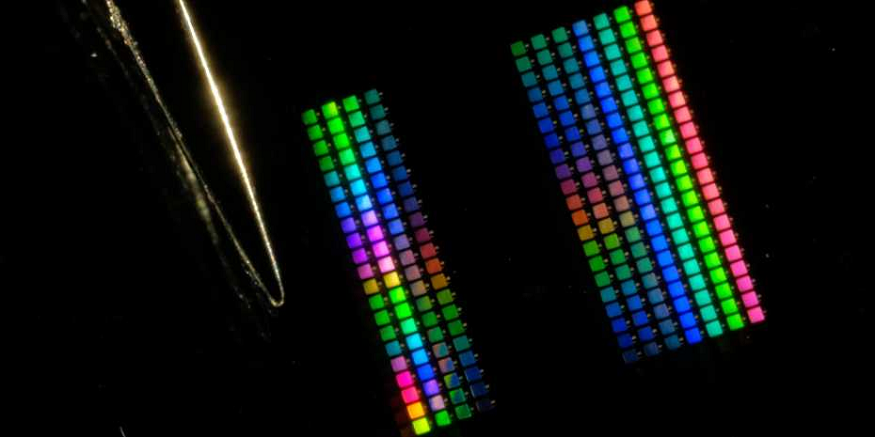From fashion and art to research in color and lightweighting, butterfly wings have inspired many an innovation, most recently a team of researchers from ETH Zurich whose latest work could one day lead to better color screens. In their study, the team explained how they used 3D printed butterfly-inspired nanostructures to create artificial, structural colors, which often have a better environmental footprint and don’t fade when exposed to light, as opposed to more typical pigments.
The abstract states, “Multilayer grating structures, such as those found on the wings of the butterfly Cynandra opis, are able to interact with light to generate structural coloration. When illuminated and viewed at defined angles, such structural color is characterized by exceptional purity and brightness. To provide further insight into the mechanism of structural coloration, two-photon laser lithography is used to fabricate bioinspired bigrating nanostructures, whose optical properties may be controlled by variation of the height and period of the grating features.”
Synthetic dyes have been in use since the 1850s, but they have a limited lifetime, brightness, and purity, as well as being bad for the environment. Longer-lasting structural coloration comes from visible light interacting with what the researchers called “periodic micro- or nano-structures,” which leads to diffraction, interference, and scattering, and this kind of color, in comparison to the kind created by light absorption, is more stable, vibrant, and tuneable. One major example of structural color found in nature is in butterfly wings.

The male of the tropical butterfly species Cynandra opis served as the model for the 3D printed structural colors. (Photograph: ETH Zurich)
The Cynandra opis butterfly species is native to tropical Africa, and its wings are beautifully colored, due to very “intricate regular surface structures in the size range of the wavelength of visible light.” These wings are what inspired the researchers in Biochemical Engineering Professor Andrew deMello’s group. The complex surface structures that cause the wing color deflect light rays, which results in either counteracting or magnifying the light’s individual color components. The team, led by deMello, used nano 3D printing to duplicate this particular butterfly’s wing surface structures.
There are, of course, other butterfly species that have wings with structural coloration, and even irregular surfaces, but this one was important for the team’s research.
Xiaobao Cao, a former doctoral student of the deMello group and lead author of this study, explained, “The regular nanostructures on the wings of Cynandra opis, however, were particularly well suited to reconstruction using 3D printing.”

The two-layer grid under the electron microscope. On the left is a detail of a butterfly wing, and on the right a portion of the 3D printed structure. The lattice spacing is around 250 nanometers. (Photograph: Cao et al. Advanced Materials 2022)
The wing structure of the Cynandra opis butterfly is made up of two grid layers, with a lattice spacing of roughly .5 to 1 micrometer, stacked perpendicular to each other. The researchers changed up the height of the lattice rods between 250 nanometers and 1.2 micrometers, as well as the lattice spacing, to 3D print structures that, as they explained, “generate all the colours of the visible spectrum,” even some that aren’t naturally occurring in the butterfly itself. They were even able to print surfaces using different materials, such as a transparent polymer.
“This made it possible to illuminate the structure from behind to bring out the colour. This is the first time we’ve managed to produce all the colours of the visible spectrum as structural colours in a translucent material,” said Stavros Stavrakis, a senior scientist in the deMello group and co-author of the study.
The researchers used two-photon polymerization, or 2PP, 3D printing, as it has previously “been used to good effect in creating polymeric structures with a resolution down to 150 nm,” and the fact that it offers excellent spatial resolution. Specifically, they used a Photonic Professional GT from Nanoscribe to 3D print the structures.

Scientists used the structural color principle to create the full color spectrum. A single pixel here measures 120 x 120 micrometers. (Photograph: Cao et al. Advanced Materials 2022)
“We show that incorporation of two crossed gratings within a single structure, mimicking features found in C. opis wings, allows the generation and tuning of structural color in a direct manner. Additionally, our integrative approach, combining optical microscopy/spectroscopy and finite-element method (FEM) simulations, enables the detailed investigation of the coloration mechanism within a variety of bigrating configurations.”
The team successfully 3D printed a small image of multi-hued, 2 x 2 micrometer, structural color pixels to test their theory, and images as tiny as this could be used in the future as a security feature on important documents. Additionally, it could be possible to fabricate color filters for optical technologies, because the researchers determined that they can produce colors with transparent material. The researchers also believe that their technique could be used to 3D print large-scale nanostructures, meaning they would be able to create high resolution color displays, like digital 3D displays and high-density storage micro image displays.

Enlargement of a miniature structural colour image that the ETH researchers 3D printed. The image measures 3.5 by 5 millimeters. (Photograph: Cao et al. Advanced Materials 2022)
Subscribe to Our Email Newsletter
Stay up-to-date on all the latest news from the 3D printing industry and receive information and offers from third party vendors.
You May Also Like
3D Printing Webinar and Event Roundup: April 21, 2024
It’s another busy week of webinars and events, starting with Hannover Messe in Germany and continuing with Metalcasting Congress, Chinaplas, TechBlick’s Innovation Festival, and more. Stratasys continues its advanced training...
3D Printing Webinar and Event Roundup: March 30, 2024
Things are slowing down a little this week, but there are still several interesting 3D printing webinars and events for you to attend. Read on for all the details! 3D...
3DPOD Episode 191: Amy Alexander, 3D Printing at the Mayo Clinic
Amy Alexander leads the 3D printing initiatives at the Mayo Clinic. You’ll be astounded by the ambitious plans this hospital has for additive manufacturing. In this episode of the 3DPOD,...
3D Printing Webinar and Event Roundup: March 3, 2024
In this week’s roundup, we have a lot of events taking place, including SPE’s ANTEC 2024, Futurebuild, the AAOP Annual Meeting, JEC World, and more. Stratasys continues its training courses,...































